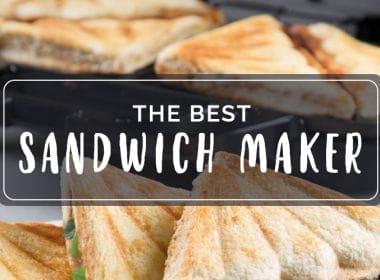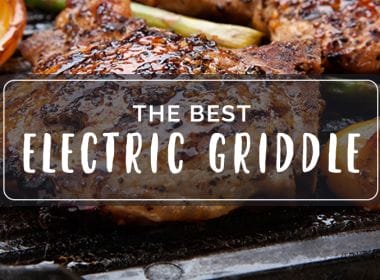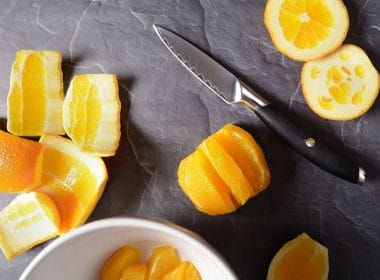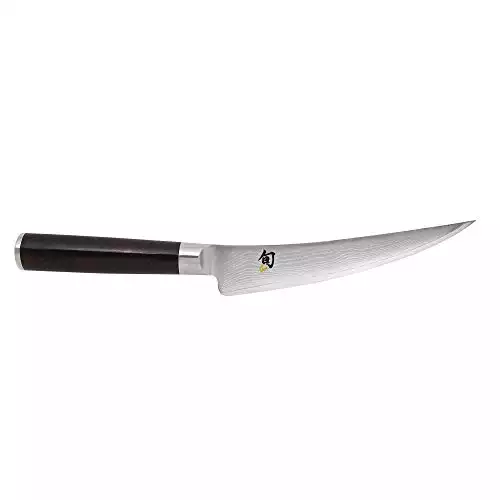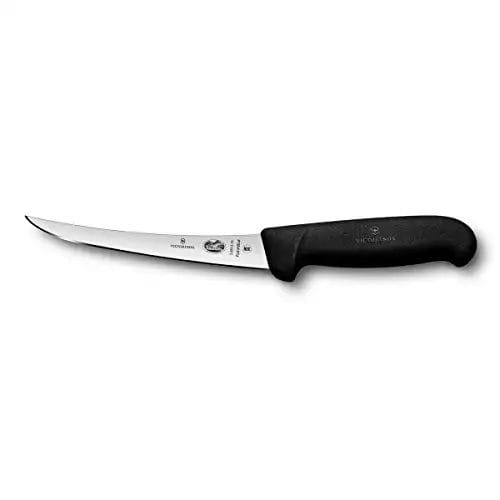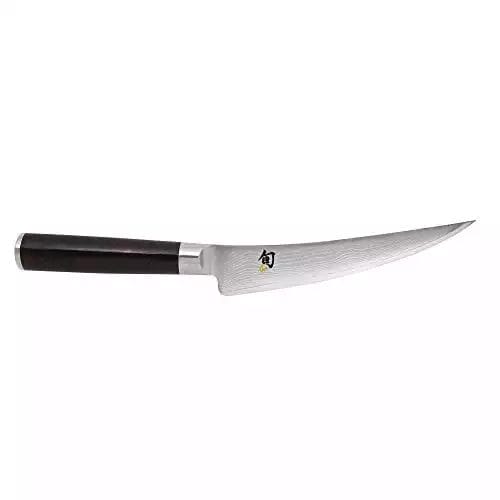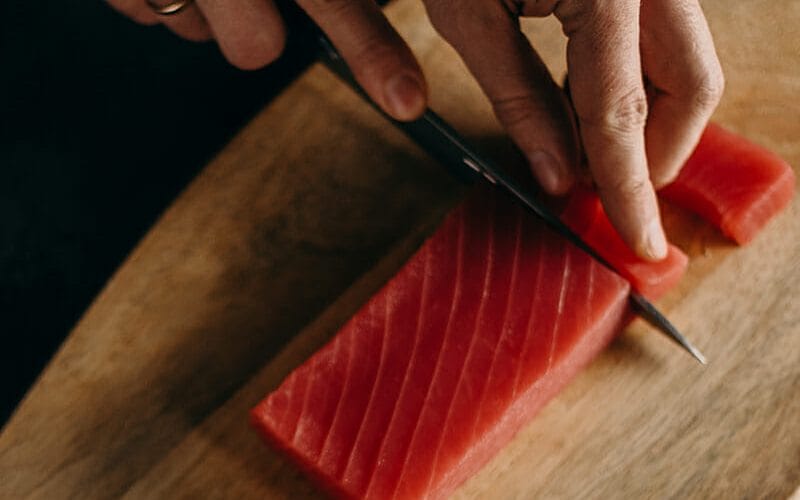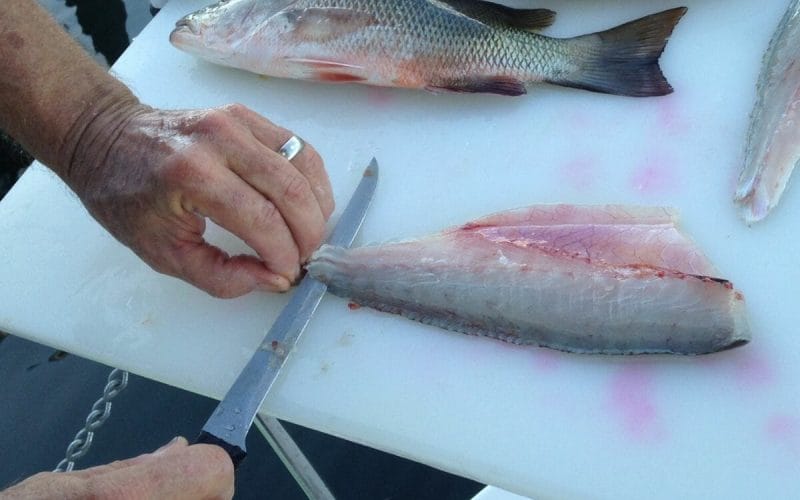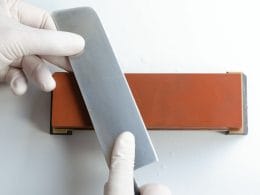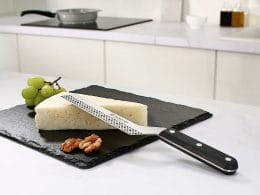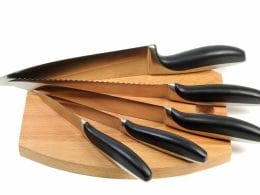Do you often find yourself deboning, slicing, and trimming all kinds of meat? Then, you’ve probably realized that a standard knife doesn’t always live up to the task.
What you’re looking for is a thin, sharp, and flexible boning knife that can get close to the bone and move seamlessly through the flesh without tearing it apart or wasting it.
The problem is that most knife sets don’t include a boning knife, and buying one requires extensive research.
Not to mention that there are countless boning knife options available, making it difficult to choose the best one.
Luckily for you, in this post, we provide you with the best boning knife options on the market. We also lay out a guideline of the features you should consider when choosing a boning knife.
Read on!
Our Favorite Boning Knives
Here’s our list of the top 3 boning knives you can get your hands on:
Wusthof Classic Boning Knife
The Wusthof Classic 5-inch is a German professional-quality knife that’s widely regarded as one of the best on the market. You’ll probably find it among the top three picks of any boning knife list—beginner or professional.
The blade is made from high-carbon stainless steel, making it stain resistant and long-lasting. It’s designed to become your go-to tool for meat preparation, with seamless deboning, slicing, and trimming.
To begin with, it’s tapered from bolster to tip, with the edge hand-honed to allow you to work as close to the bones as possible.
What’s more, the blade is sharp, arched, and semi-flexible. As such, it’s easy to maneuver around any cut of meat, regardless of size or toughness.
The best part is that the blade has a bolster/finger guard near the handle, which not only prevents injuries but also balances the weight of the knife.
The handle itself is triple-riveted to the blade for better control and stability. It’s also made from a highly durable synthetic that’s designed to resist discoloration and fading.
Granted that this knife falls on the higher end of the price spectrum. Still, it’s a durable knife that can last you for years, which makes it worth the price.
Pros:
- Excellent edge retention – takes twice as long as other blades to need sharpening
- Solid balance – has Wusthof’s signature bolster, which makes it easy to maneuver the blade
- Safe design – has a full bolster/finger guard
Cons:
- Polypropylene handle – can become uncomfortable and offer little to no grip
Victorinox Fibrox Pro Boning Knife
You don’t need to spend over $100 to have a boning knife, especially if this is your first one. The Fibrox Pro Boning Knife, from the renowned Swiss knife manufacturer Victorinox, is a 6-inch lightweight, easy-to-maintain, and long-lasting stainless steel blade.
What we like best about Victorinox’s boning knives is that they come in all shapes and degrees of flexibility. So, whether you prefer a curved, semi-stiff blade or a straight, flexible blade, Victorinox has you covered.
Still, because slight flexibility is needed for deboning, even the stiffest blade can maneuver around bones. Just make sure to use it on tougher, thicker meats with fewer intricate bones to get the best results.
Perhaps the only downside of this knife is that it’s so sharp that it can be dangerous for inexperienced cooks to use.
Luckily, the knife’s non-slip Fibrox handle will likely keep your hands from slipping, even if they’re wet, oily, or bloody. It also gives you control and balance over the knife, allowing you to maneuver through even the most delicate meats.
Even better, the handle’s design is meant to provide a comfortable grip, reducing hand and wrist fatigue even after hours of use or when working on large cuts.
It’s worth mentioning that this knife comes with a lifetime warranty.
Pros:
- Versatile – designed to cut through all kinds of meat
- Ergonomic handle – allows for a comfortable, firm grip
- Value for money – offers similar features as other more expensive boning knives
Cons:
- Poor edge retention – requires frequent sharpening
Shun Cutlery Classic Boning and Fillet Knife
If you’re looking for a high-quality two-in-one knife, this is the one. The Shun Cutlery Classic Boning and Fillet Knife is a stunning handcrafted curved steel blade with a hammered finish and an ebony-finished wood handle.
This knife is more than just a showpiece, though. Whatever task you use this knife for will be a quick process thanks to its razor-sharp Damascus steel blade. It’s a 6-inch narrow curved blade with a superfine pointy tip that allows the knife to get close to the bone.
What’s more, the hammered finish not only makes the blade look sleek but also acts as a non-stick surface. This allows the blade to glide through the meat with ease.
That said, we wouldn’t recommend using this knife on tougher cuts like beef or lamb. The blade is quite flexible so that it can function as both a boning and a fillet knife. So, it’s better suited for poultry, fish, and other delicate cuts.
Still, to make using the knife more enjoyable, the handle is D-shaped to fit comfortably in either your left or right hand. You’ll also have a more secure grip, which will give you excellent control and precision.
Just keep in mind that this knife requires a certain amount of care to stay in optimum condition. Otherwise, the blade and handle may rust, discolor, warp, or separate.
Pros:
- Sleek appearance – has a hammered-finish curved blade and an ebony-finished handle
- High-quality material – made from a 68-layer stainless Damascus steel and Pakkawood
- Ergonomic handle and blade design – allows for a comfortable, secure grip while effortlessly cutting through meat
Cons:
- Expensive – costs a lot more than other boning knives of comparable quality
Boning Knife Buyer’s Guide
In this section, we’ll go over some key features to consider when choosing the best boning knife for your kitchen.
Blade Material
Because boning knives come into contact with bones often, you want the blade to be extremely durable and capable of retaining its edge. That’s why stainless steel boning knife blades are the most popular and recommended option.
Stainless steel is known for its excellent wear resistance and edge retention, as well as its high corrosion and rust resistance. It’s also strong and flexible enough to absorb impacts without breaking or chipping.
Alloy steel is another less common but equally durable material for boning knife blades. In comparison to stainless steel, alloy steel has higher levels of wear and tear resistance. Nevertheless, alloy steel is less resistant to corrosion, so it requires more maintenance.
Blade Length
On average, the length of a boning knife blade is between five to seven inches. Each length has its purpose, so you need to consider the size of the meat you’ll be working with before choosing the best blade length for you.
If you’re going to use a boning knife for jointing, seaming, or trimming, you’ll want less flexibility and more control. As such, a short blade is ideal. It’s useful for deboning small cuts of meat, like small fish and chicken legs.
A longer blade, on the other hand, is more flexible, allowing you to make long, swift cuts with ease. It’s especially useful for breaking down large chunks of meat as well as whole poultry or fish.
Blade Flexibility
Boning knives should be flexible enough to allow you to get closer to the bone and joints without wasting any meat.
A semi-stiff blade is best for deboning tough, thick cuts of meat like beef, goat, lamb, or pork. However, if you’re deboning more delicate cuts, such as poultry or fish, a more flexible blade is preferable.
Most importantly, avoid overly flexible blades, which can bend when cutting around or through bones, resulting in blade damage or an accident.
Blade Shape
Boning knives come in two shapes: curved and straight.
Curved blades are more flexible and can easily maneuver around bones and joints while maintaining precision. While they’re not as sharp, they’re more forgiving, making them better suited for delicate cuts.
Straight boning knives, on the other hand, are more precise and sharp, making them ideal for seaming and slicing through tough meat. They’re also a better option when working with large, thick cuts of meat. That said, they can waste a bit of meat.
Knife Handle
No matter how wet, oily, or bloody your hands get, a knife handle must provide adequate comfort and grip. Otherwise, there’s a risk of mishap and ruined meat.
There’s no one-size-fits-all knife handle, though. So, look for a boning knife with no edges that dig into your hands or material that’s too abrasive.
Regardless of the handle material you prefer, make sure to hand wash your knife in warm, soapy water rather than using the dishwasher to ensure its longevity.
Final Thoughts
The three boning knives on our list are designed to make deboning and breaking down meat a breeze. Still, each comes with unique features that set it apart from the others.
While it’s not the cheapest boning knife out there, the Wusthof Classic 5-inch is a worthy investment. It’s a lightweight, durable, sharp, and precise knife that’s also easy to use, making it ideal for amateurs and professionals.
Nevertheless, if you’re looking for a comparable option that won’t break the bank, the Victorinox Fibrox Pro Boning Knife is a serious competitor.
If you’re still unsure about which boning knife to choose, you can go through the buyer’s guide. It’ll provide you with all of the information you need to make an informed decision and buy the best boning knife for your kitchen!


